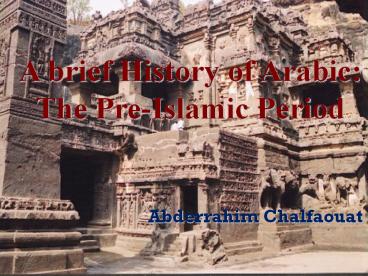A brief History of Arabic: The Pre-Islamic Period - PowerPoint PPT Presentation
Title:
A brief History of Arabic: The Pre-Islamic Period
Description:
A brief History of Arabic: The Pre-Islamic Period Abderrahim Chalfaouat Introduction Semitic Origins Perishing Arab tribes Ancient Arabic Dialects: Old South-Arabian ... – PowerPoint PPT presentation
Number of Views:2862
Avg rating:3.0/5.0
Title: A brief History of Arabic: The Pre-Islamic Period
1
A brief History of ArabicThe Pre-Islamic Period
Abderrahim Chalfaouat
2
Outline
- Introduction
- Semitic Origins
- Perishing Arab tribes
- Ancient Arabic Dialects
- Old South-Arabian Dialects
- North-Arabian Dialects
- Influence of Adjacent Dialects
- Influence of Adjacent Languages
- Diglossia
- Arabia in the 7th Century
- Conclusion
3
Introduction
- Offspring of Sam son of Noah Assyrians,
Babylonians, Hebrew, Phoenicians, Aramians, Arabs
and Ethiopians. - Much interaction and exchange happened between
them. - Before Islam, Arabic was a minor language
- Arabs in the North lived in nomadic tribes while
in the South they traded with other peoples. - Writing was not as widespread a trade as speaking
- Proto-Arabic
4
Semitic Origins
5
by Elie Wardini on http//almashriq.hiof.no/genera
l/400/410/Semitic-Lang-Map.html
6
What Do they Have in Common?
- The six vowel system three long and three short
- Writing from right to left
- Vowels used for changing word category
- Infixation more frequent than pre- or suffixation
- Roots are mostly three lettered
- Singular- dual- plural
- Nouns and adjectives different between masculine
and feminine
7
Ancient Arabic Dialects
- Perishing Arab tribes Tribes that lived in the
Empty Quarter - Four main tribes Tasm, Jadis, Ad and Thamud
- Little remains for linguistic study.
- Religious books mention them, but many myths are
told especially by pre-Islam religious leaders. - They perished because of wars and divine
punishment.
8
Old South Arabian
- Tribes that flourished in Yemen including the
kingdoms of Saba, Himyar and Hadramaut. - Descendants of Yareb Ben Qahtan, a progeny of Ad.
- They spoke many dialects of Himyarian Arabic.
- They were in constant contact with other
Mediterranean civilizations. - The Arab poet ???? ?? ????considered them the
teachers of Northern Arabs. - Ibn Khaldoun in his Introduction mentions the
linguistic differences between South and North
Arabian.
???? ?? ???? ?????? ?? ???? ????? ????
?????? ????? ?????? ??? ??? ? ???? ????? ?? ???
??? ???? ????? ? ???? ???????? ?? ????? ???
????? ? ??? ???? ??? ???? ?????? ???? ??? ??
???? ?? ??????? ? ???????? ? ????? ???????
9
Old South Arabian (cont)
- Archaeologists have discovered in Yemen a number
of limestones, dating back to few centuries
before the rise of Islam - They generally account personal matters
- Some archaeologists doubt that those great
traders did not record their history. - Many of them moved Northward after successive
draughts followed by the destruction of Maarib
Dam. - The Jorhom tribe were very became strong in North
Arabia - Ismail son of Ibrahim lived among them and learnt
Arabic.
10
(No Transcript)
11
North Arabian Dialects
- Tribes such as Ghassassinide, Khuzaa, Aws,
Khazraj, Tai, Manathiride immigrated from the
South. - Many of them reigned supreme in the region.
- North Arabia was home to nomadic tribes
- Tribes in remote areas were considered more
eloquent and their Arabic purer. - They generally spoke Adnanite Arabic
12
North Arabic Dialects (cont)
- Differences between tribal dialects took place at
the level of vocabulary, pronunciation and word
derivation.
????? ????? ?????
??? ???? ??? ????
?????? ?????? ?????
?????? ??????? ??????
?? ???? ??? ????? ??? ???? ??? ???? The prisoner of war ?? ???? ??? ????? ??? ???? ??? ???? The prisoner of war ?? ???? ??? ????? ??? ???? ??? ???? The prisoner of war
13
Influence of Adjacent Languages
- Direct contact with other nations (Persians,
Romans, etc) was very little. - Trading caravans brought with them terms related
to tools, trees, textile, and medicines. - The transfer of Greek works took place through
the Soryani translations by the Christian
scholars mostly Nestorians and some Jacobites - from the schools of Mesopotamia and Syria, during
the 4th through the 9th centuries A.D., but its
influence occured after the rise of Islam.
14
Influence of Adjacent Languages
- It is generally accepted that the Arabic script
developed from Nabataean, a dialect of Aramaic.
15
Diglossia
- The co-existence of two different varieties
started before Islam - Mecca became the center of the region for
religious (pilgrimage), economic (trade) and
poetic (Okad market) reasons. - Mecca dialect became a lingua franca different
from other tribal dialects - Arab poetry and the Quran and Hadiths used Mecca
dialect (the Koine theory). - The written form simulates early versions
- The spoken forms changed with time to result in
present day dialects
16
Arabia in the 7th Century
- Mecca became the heart of the area in terms of
religion, economy and trade, literature, etc. - Abraha tried to topple down the Old Mosque
- Much linguistic interaction took place.
- The circumstances were very ready for the start
of a new era, language change and novel
linguistic contacts included.
17
Conclusion
- The importance of Arabic occured mainly after
Islam
18
- Thank you
19
References
- Bibliography
- ????????? ????. ????? ????? ?? ???????? ? ???
???????. ? 1. ????? ??? ????? ????. 1979. - ??? ?????? ??? ??????. ????? ??? ?????. ?????
??????? ???????. 2004. - ???? ????. ?????? ?? ????? ????? ??? ???????.
????? ????? ?????. ? 1. 1993 - De Lacy O. L., How Greek Science Passed to the
Arabs. Chicago Ares Publishers Inc. 1979). - Webliography
- http//www.indiana.edu/arabic/arabic_history.htm
- http//almashriq.hiof.no/
- http//linguistics.byu.edu/classes/ling450ch/repor
ts/arabic.html
20
(No Transcript)

